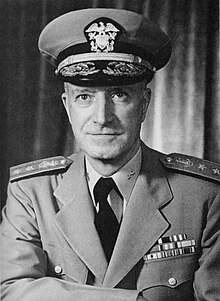
Back ويليام ستيرلينغ بارسونز Arabic ويليام ستيرلينج بارسونز ARZ William Sterling Parsons Czech William Sterling Parsons German William Sterling Parsons Spanish ویلیام استرلینگ پارسونز Persian William Sterling Parsons Finnish William Sterling Parsons French William Sterling Parsons ID William Sterling Parsons NB
William Sterling Parsons | |
|---|---|
 Parsons c. 1946–1953 | |
| Nickname(s) | Deak |
| Born | 26 November 1901 Chicago, Illinois, US |
| Died | 5 December 1953 (aged 52) Bethesda, Maryland, US |
| Place of burial | |
| Allegiance | United States |
| Service/ | United States Navy |
| Years of service | 1922–1953 |
| Rank | Rear admiral (upper half) |
| Battles/wars | |
| Awards | |
| Alma mater | United States Naval Academy (BS) |
William Sterling Parsons (26 November 1901 – 5 December 1953) was an American naval officer who worked as an ordnance expert on the Manhattan Project during World War II. He is best known for being the weaponeer on the Enola Gay, the aircraft which dropped an atomic bomb on Hiroshima, Japan, in 1945. To avoid the possibility of a nuclear explosion if the aircraft crashed and burned on takeoff, he decided to arm the bomb in flight. While the aircraft was en route to Hiroshima, Parsons climbed into the cramped and dark bomb bay, and inserted the powder charge and detonator. He was awarded the Silver Star for his part in the mission.
A 1922 graduate of the United States Naval Academy, Parsons served on a variety of warships beginning with the battleship USS Idaho. He was trained in ordnance and studied ballistics under L. T. E. Thompson at the Naval Proving Ground in Dahlgren, Virginia. In July 1933, Parsons became liaison officer between the Bureau of Ordnance and the Naval Research Laboratory. He became interested in radar and was one of the first to recognize its potential to locate ships and aircraft, and perhaps even track shells in flight. In September 1940, Parsons and Merle Tuve of the National Defense Research Committee began work on the development of the proximity fuze, an invention that was provided to the US by the UK Tizard Mission, a radar-triggered fuze that would explode a shell in the proximity of the target. The fuze, eventually known as the VT (variable time) fuze, Mark 32, went into production in 1942. Parsons was on hand to watch the cruiser USS Helena shoot down the first enemy aircraft with a VT fuze in the Solomon Islands in January 1943.
In June 1943, Parsons joined the Manhattan Project as Associate Director at the Project Y research laboratory at Los Alamos, New Mexico, under J. Robert Oppenheimer. Parsons became responsible for the ordnance aspects of the project, including the design and testing of the non-nuclear components of nuclear weapons. In a reorganization in 1944, he lost responsibility for the implosion-type fission weapon, but retained that for the design and development of the gun-type fission weapon, which eventually became Little Boy. He was also responsible for the delivery program, codenamed Project Alberta. He watched the Trinity nuclear test from a B-29.
After the war, Parsons was promoted to the rank of rear admiral without ever having commanded a ship. He participated in Operation Crossroads, the nuclear weapon tests at Bikini Atoll in 1946, and later the Operation Sandstone tests at Enewetak Atoll in 1948. In 1947, he became deputy commander of the Armed Forces Special Weapons Project. He died of a heart attack in 1953.